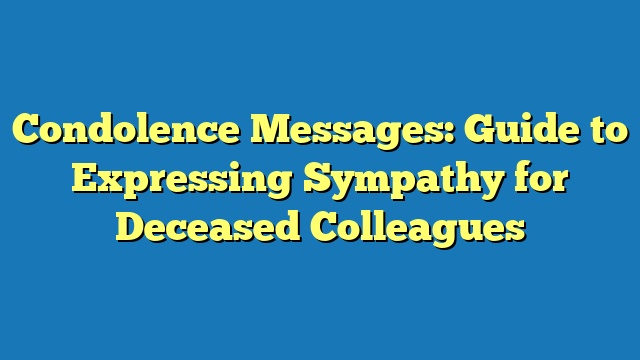An official condolence message on the death of a colleague is a formal expression of sympathy and support sent to the family and friends of a deceased coworker. It typically includes words of comfort, acknowledgment of the loss, and offers of assistance.
Official condolence messages are important because they provide a way for the organization to express its condolences and support to the bereaved family. They can also help to create a sense of community and support within the workplace.
Historically, official condolence messages were often sent in the form of letters or telegrams. However, with the advent of email and other electronic communication methods, it has become more common to send condolence messages electronically.
Official Condolence Message on Death of Colleague
When a colleague passes away, it is important to send an official condolence message to the family and friends of the deceased. This message should be sincere, respectful, and professional.
- Tone: The tone of the message should be somber and respectful.
- Length: The message should be brief and to the point.
- Content: The message should include an expression of sympathy, an acknowledgment of the loss, and an offer of support.
- Personalization: The message should be personalized to the recipient, if possible.
- Timing: The message should be sent as soon as possible after the death of the colleague.
- Delivery: The message can be sent via email, mail, or in person.
- Follow-up: It is important to follow up with the recipient of the message to offer continued support.
- Company policy: Some companies have a policy on sending condolence messages. Be sure to follow the company’s policy when sending a message.
- Legal considerations: There are some legal considerations to keep in mind when sending a condolence message. For example, avoid making any statements that could be construed as defamatory or negligent.
By following these guidelines, you can ensure that your official condolence message is respectful, supportive, and appropriate.
Tone
When sending an official condolence message on the death of a colleague, it is important to use a somber and respectful tone. This means avoiding any language that could be construed as flippant, dismissive, or insensitive.
- Empathy: The message should express empathy for the recipient’s loss. This can be done by using phrases such as “I am so sorry for your loss” or “My thoughts are with you during this difficult time.”
- Respect: The message should show respect for the deceased and their family. This means avoiding any language that could be seen as disrespectful or dismissive.
- Professionalism: The message should be professional in tone. This means avoiding any slang or colloquialisms, and using formal language.
- Brevity: The message should be brief and to the point. This is not the time to write a long, rambling letter. A few short sentences will suffice.
By following these guidelines, you can ensure that your official condolence message is respectful, supportive, and appropriate.
Length
When sending an official condolence message on the death of a colleague, it is important to keep the message brief and to the point. This is not the time to write a long, rambling letter. A few short sentences will suffice.
- Conciseness: The message should be concise and to the point. Avoid using unnecessary words or phrases.
- Clarity: The message should be clear and easy to understand. Avoid using jargon or technical terms.
- Focus: The message should focus on expressing sympathy and support. Avoid getting bogged down in details.
- Respect: A brief message shows respect for the recipient’s time and attention.
By following these guidelines, you can ensure that your official condolence message is respectful, supportive, and appropriate.
Content
The content of an official condolence message on the death of a colleague is crucial in conveying the organization’s sympathy and support to the bereaved family. It should include three key elements: an expression of sympathy, an acknowledgment of the loss, and an offer of support.
-
Expression of Sympathy
The message should begin with a sincere expression of sympathy to the recipient. This can be done by using phrases such as “We are deeply saddened to hear of the passing of your colleague” or “Our thoughts are with you during this difficult time.”
-
Acknowledgment of the Loss
The message should also acknowledge the loss of the deceased colleague. This can be done by mentioning the colleague’s name and their role in the organization. For example, “We will miss [colleague’s name]’s dedication and hard work.”
-
Offer of Support
The message should include an offer of support to the recipient. This can be done by offering practical help, such as providing meals or running errands, or by simply offering emotional support. For example, “Please do not hesitate to reach out if there is anything we can do to help.”
By including these three elements, the official condolence message will be meaningful and supportive to the bereaved family.
Personalization
In the context of an official condolence message on the death of a colleague, personalization is crucial for delivering a meaningful and supportive message to the bereaved family. By tailoring the message to the specific recipient, the organization can demonstrate its genuine care and concern.
-
Recipient’s Name
Including the recipient’s name in the message adds a personal touch and shows that the message is intended specifically for them.
-
Colleague’s Name
Mentioning the deceased colleague’s name shows that the organization remembers and values the colleague’s contribution.
-
Specific Memories
If appropriate, sharing a specific memory or anecdote about the deceased colleague can make the message more personal and meaningful.
-
Offer of Tailored Support
Tailoring the offer of support to the recipient’s specific needs shows that the organization is genuinely interested in providing assistance.
By personalizing the official condolence message, the organization can create a more meaningful and supportive message that will be appreciated by the bereaved family.
Timing
When a colleague passes away, it is important to send an official condolence message to the family and friends of the deceased as soon as possible. This is because timely communication demonstrates respect and support during a difficult time. An immediate response shows that the organization is thinking of the bereaved family and that their loss is acknowledged.
Moreover, sending a condolence message promptly allows the recipient to know that they are not alone in their grief. It provides an opportunity for the organization to express its sympathy and offer support, which can be a source of comfort during a time of sorrow. By reaching out in a timely manner, the organization can help the bereaved family begin the healing process.
In addition, sending a condolence message as soon as possible after the death of a colleague is important for practical reasons. It allows the organization to coordinate any necessary support services, such as bereavement counseling or financial assistance. A timely message ensures that the family has access to these services when they need them most.
In conclusion, sending an official condolence message on the death of a colleague as soon as possible is essential for demonstrating respect, providing support, and facilitating practical assistance. It is a meaningful gesture that can make a real difference during a difficult time.
Delivery
The delivery method of an official condolence message on the death of a colleague can have a significant impact on its effectiveness. Choosing the right delivery method depends on several factors, including the urgency of the message, the recipient’s preferences, and the organization’s policies.
For urgent messages, email is often the best option. It is a fast and convenient way to reach the recipient, and it allows the sender to include attachments, such as a sympathy card or a memorial donation form. However, email may not be appropriate in all cases. For example, if the recipient is not comfortable with email communication, or if the message is particularly sensitive, it may be better to send it via mail or in person.
Mail is a more formal way to send a condolence message. It is a good option for organizations that want to send a message that is both respectful and heartfelt. However, mail can be slower than email, and it may not be the best option for urgent messages. In-person delivery is the most personal way to send a condolence message. It allows the sender to express their sympathy in person and to offer support to the recipient. However, in-person delivery may not be possible in all cases, such as when the recipient lives far away or when the sender does not know the recipient well.
Ultimately, the best way to deliver an official condolence message on the death of a colleague is to choose the method that is most appropriate for the specific situation. By considering the factors discussed above, organizations can ensure that their messages are delivered in a timely, respectful, and supportive manner.
Follow-up
Following up with the recipient of an official condolence message on the death of a colleague is a crucial aspect of providing genuine support during a difficult time. It demonstrates the organization’s ongoing care and concern for the bereaved individual.
-
Checking In
Regularly checking in with the recipient shows that the organization is not simply sending a one-time message but is committed to providing ongoing support. This can be done through phone calls, emails, or in-person visits.
-
Offering Practical Assistance
In addition to emotional support, follow-up can involve offering practical assistance. This may include providing meals, running errands, or helping with childcare or household tasks.
-
Honoring the Deceased
Follow-up can also include honoring the memory of the deceased colleague. This could involve planting a tree in their memory, establishing a scholarship in their name, or creating a memorial fund.
-
Professional and Personal Support
The organization should provide both professional and personal support to the recipient. Professional support may include offering counseling services or connecting the recipient with support groups. Personal support involves simply being present and listening to the recipient’s needs.
By incorporating these follow-up measures into the official condolence message, organizations can create a comprehensive support system for bereaved individuals, demonstrating their commitment to providing care and support beyond the initial message.
Company policy
When sending an official condolence message on the death of a colleague, it is important to be aware of any company policies that may exist regarding such communication. Many companies have established guidelines to ensure that condolence messages are sent in a timely, respectful, and appropriate manner.
-
Purpose of company policy
Company policies on condolence messages serve several purposes. They ensure consistency in the tone, content, and timing of messages sent on behalf of the organization. They also help to protect the company from legal liability by providing guidance on what can and cannot be said in a condolence message.
-
Content of company policy
Company policies on condolence messages typically include guidelines on the following:
- Who should send the message
- When the message should be sent
- What the message should include
- How the message should be sent
-
Benefits of following company policy
There are several benefits to following company policy when sending condolence messages. It helps to:
- Ensure that messages are sent in a timely and appropriate manner
- Maintain a consistent and professional image for the company
- Protect the company from legal liability
-
Consequences of not following company policy
Failing to follow company policy on condolence messages can have several consequences. It can:
- Offend the recipient of the message
- Damage the company’s reputation
- Result in legal liability
By following company policy on condolence messages, organizations can ensure that they are sending messages that are respectful, appropriate, and legally compliant.
Legal considerations
When sending an official condolence message on the death of a colleague, it is important to be aware of certain legal considerations to avoid potential legal liability. These considerations include:
-
Defamation
Defamation is a false statement that injures a person’s reputation. When writing a condolence message, it is important to avoid making any statements that could be construed as defamatory. For example, you should not make any negative comments about the deceased person or their family.
-
Negligence
Negligence is the failure to act with reasonable care. When sending a condolence message, it is important to take reasonable care to avoid causing any harm to the recipient. For example, you should not send a message that is insensitive or offensive.
-
Privacy
Privacy is the right to be left alone. When sending a condolence message, it is important to respect the privacy of the recipient. For example, you should not share any personal information about the deceased person or their family without their consent.
-
Copyright
Copyright is the exclusive right to reproduce, distribute, and adapt a creative work. When sending a condolence message, it is important to be aware of the copyright status of any material you include in the message. For example, you should not include any copyrighted material without the permission of the copyright holder.
By being aware of these legal considerations, you can help to ensure that your official condolence message is respectful, appropriate, and legally compliant.
FAQs on Official Condolence Messages for Deceased Colleagues
This section addresses frequently asked questions and provides clear answers to enhance understanding of official condolence messages sent upon the passing of a colleague.
Question 1: What is the purpose of an official condolence message for a deceased colleague?
An official condolence message expresses the organization’s sympathy and support to the bereaved family and friends of the deceased colleague.
Question 2: Who is responsible for sending an official condolence message?
Typically, the organization’s designated spokesperson or a senior representative sends the official condolence message.
Question 3: What should an official condolence message include?
An effective condolence message includes an expression of sympathy, acknowledgment of the loss, offer of support, and may mention the deceased colleague’s contributions.
Question 4: What is the appropriate tone for an official condolence message?
The tone should be somber, respectful, and professional, conveying empathy and support.
Question 5: How should an official condolence message be delivered?
Condolence messages can be sent via email, mail, or in person, depending on the circumstances and company policy.
Question 6: What legal considerations should be kept in mind when drafting an official condolence message?
Avoid making defamatory or negligent statements, respect privacy, and ensure compliance with copyright laws.
These FAQs provide guidance on the purpose, content, tone, and delivery of official condolence messages, offering a comprehensive understanding of this important communication.
In the next section, we will explore best practices for expressing empathy and offering support in official condolence messages.
Tips for Expressing Empathy and Offering Support in Official Condolence Messages
Expressing empathy and offering meaningful support in official condolence messages is crucial for conveying genuine care and concern. Here are some actionable tips to enhance the effectiveness of your messages:
Tip 1: Use sincere and specific language: Avoid generic phrases and instead express heartfelt sympathy using specific words that acknowledge the unique qualities of the deceased colleague.
Tip 2: Offer tangible support: In addition to words of comfort, provide practical assistance such as offering to help with funeral arrangements, running errands, or providing meals.
Tip 3: Respect the recipient’s needs: Understand that everyone grieves differently. Allow the recipient to set the pace and respect their wishes for privacy or support.
Tip 4: Avoid clichs and platitudes: While well-intentioned, clichs can sometimes come across as insincere. Instead, focus on sharing genuine and personal thoughts.
Tip 5: Proofread carefully: Ensure your message is free of errors and conveys the intended tone of sympathy and respect.
Summary: By following these tips, you can create official condolence messages that convey genuine empathy, offer meaningful support, and provide comfort during a difficult time.
In the final section, we will explore the importance of cultural sensitivity in official condolence messages.
Conclusion
Official condolence messages play a crucial role in expressing sympathy and support to bereaved families and colleagues after the loss of a valued member. By adhering to best practices, organizations can create meaningful messages that provide genuine comfort and assistance during a difficult time. Key considerations include using sincere and specific language, offering tangible support, respecting the recipient’s needs, avoiding clichs, and proofreading carefully.
Cultural sensitivity is also essential, as different cultures have unique customs and beliefs surrounding death and mourning. By understanding and respecting these differences, organizations can ensure that their condolence messages are appropriate and respectful.









Tips for Using "Template by Kevin Crafts" Comments for Meaningful Online Discussions